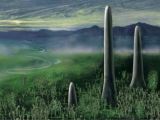How big can a mushroom be? A few tens of pounds and with a 2-3 ft diameter? That's small, compared to the largest one that ever existed: as big as a tree!
A team at the University of Chicago and the National Museum of Natural History in Washington, D.C., has come with conclusive evidence that one of the weirdest and most mysterious fossils ever found, discovered in 1859 and widespread at its time (from Canada to Arabia and Australia), is a fungus.
Named Prototaxites, the genus lived about 420 to 350 million years ago (Silurian-Devonian eras) but nobody could tell if the tree-like trunks, surpassing 20 ft (6 m) (which made it the largest land organism of its time) belonged to a conifer, a lichen, an algae or a fungus.
"A 20-foot-tall fungus doesn't make any sense. Neither does a 20-foot-tall algae make any sense, but here's the fossil." said C. Kevin Boyce, an Assistant Professor in Geophysical Sciences at UC.
In 1919, Francis Hueber of the National Museum of Natural History was the first to point that the internal structure was that of a fungus, not a plant.
"But (...) he was never able to find a smoking gun in the form of reproductive structures that would convince the world that it was indeed a fungus," said Carol Hotton, also of the National Museum of Natural History.
During Prototaxites's time the land was covered only by simple vascular plants, the ancestors of the familiar conifers, ferns of today, rootless and leafless green stems. Vertebrates had still not conquered the land which was swarming just with invertebrates: millipedes, wingless insects and worms.
Even if the first vascular plants had colonized the land 40 million years before the existence of Prototaxites, the highest among them were no taller than a couple of ft (0.7 m) and only by the end of the Devonian, about 345 million years ago, leaves and roots had evolved, leading to large tree ferns.
The research team investigated two isotopes of carbon from Prototaxites and contemporaneous vascular plants.
In plants, as they achieve carbon through photosynthesis from air carbon dioxide, any given type of plant will typically contain a similar ratio of carbon-12 to carbon-13 as another plant of the same type. "But if you're an animal, you will look like whatever you eat," Boyce said. Prototaxites presented a higher variation in its C12 to C13 ratio than in any plant.
The team also proved that the carbon isotopic ratio of the specimens they had analyzed was because of organic, not geologic factors."I've wondered whether it enabled Prototaxites to distribute its spores widely, allowing it to occupy suitable marshy habitats that may have been patchily distributed on the landscape," Hotton said.
But the giant fungus could have lived only in the simple Devonian ecosystems.
"Plant-eating animals had not yet evolved. But even if Prototaxites hadn't been eaten by the dinosaurs and elephants that came much later, they probably grew too slowly to rebuild from regular disturbances of any kind. It's hard to imagine these things surviving in the modern world," said Boyce.

 14 DAY TRIAL //
14 DAY TRIAL // 
